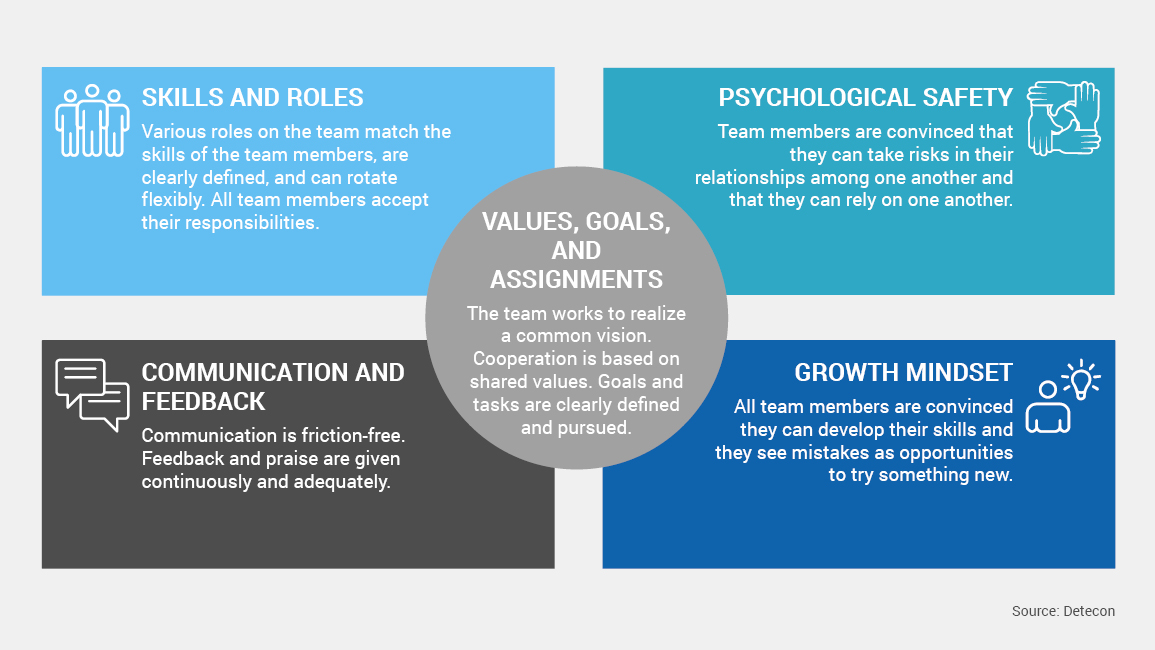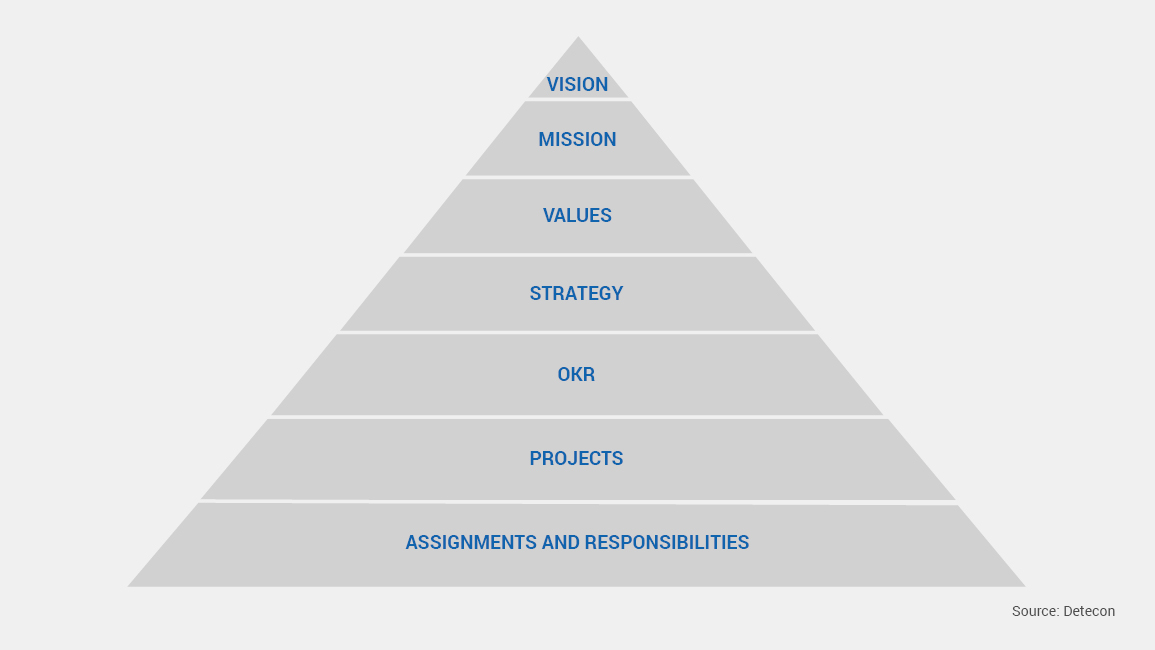The line between enthusiasm and disillusionment during projects is often a thin one. The team, chomping at the bit and highly motivated at the (virtual) kick-off, boasts tons of mental prowess, and the idea that anything could stand in the way of the project’s success appears ridiculous. But only a few weeks later, the initial euphoria has completely evaporated.
Failed projects, wasted capital, process slowdowns, or paralysis of entire organizations — dysfunctional teams are deadly for business success. But there is another way: the creation of a culture for high performing teams.
What is a high performing team?
A high performing team is one that consistently meets or exceeds defined expectations — and is able to set goals, make decisions, communicate, manage conflict, and solve problems effectively in a supportive and trusting atmosphere (Murray, 2012; Dyer et al., 2007). Success is measured by the results achieved by the team as a whole rather than by the individual performance of the team members. I cannot simply compile a team of individual “high performers” and expect this team to achieve top performance automatically.
The figure below shows an overview of the criteria for a high performing team that have been identified by Detecon.

Values, goals, and assignments
A high performing team should define for itself a common vision or image of the future. The path to this vision can be laid down in a mission statement describing the route and the steps to be taken to realize the vision. Taking into consideration the values of the individual team members is always rewarding as a means of avoiding conflicts.
The OKR method has proved to be an effective way to steer the progress of the team. OKR stands for “objectives and key results.” “Objectives” describe what goals are relevant for the team in the short term (a period of approximately three to nine months). The “key results” make the objectives measurable by clearly defining metrics and focusing on the results, on concrete outcomes. They can subsequently be used to derive conclusions about the required projects.

Assignments, expectations, responsibilities, and the rules of the game in a high performing team should also be clarified and recorded in a backlog in combination with a RACI matrix as this step creates clarity about what the team is expected to accomplish in the next two to four weeks and who is responsible for what.
Using the right tools is another critical element of success. Equally important is meeting hygiene, the elimination of unproductive or redundant regular meetings.
Skills and roles
Once the concrete goals and related assignments have been clearly determined, they can be used as the basis for concluding what skills are required. A distinction can be made among four types:
- Professional skills: the acquired knowledge on specific topics
- Methodological skills: facilitation, problem solving, for instance
- Social skills: non-technical qualifications such as the ability to deal with conflict or the willingness to change
- Personal skills: a person’s willingness to develop, e.g., courage, willingness to learn, or flexibility
The required roles on the team should then be established on the basis of the determined skills. The “Belbin Team Roles” have proved to be a useful tool for this purpose (Belbin, 2010). Ideally, however, team members should be allowed to rotate flexibly among various roles. Every team member of a high performing team will ideally realize two to three different roles. The more roles that can be covered, the more successful and effective the team can work.
Living and breathing communication
Communication is absolutely essential for your team to become a high performing team. Visible behavior, gestures, and facial expressions are only the tip of the iceberg. Everything that is not clearly revealed — emotions, desires, expectations, motives, or even goals — plays a far more important role and is an inherent source of major potential for conflict. Continuous feedback and detection and correction of “blind spots” ward off misunderstandings before they occur and enhance the quality of communication.
Psychological safety
The importance of psychological safety in these situations must not be underestimated. Team members should feel free to contribute critical observations at any time, to take risks, and to ask for help without fear of negative consequences. Moreover, their performance should be recognized with sufficient praise and appreciation. Team members are not ostracized by others because they are different; instead, the unique abilities of each individual are valued (Edmondson, 1999).
As a team member and as a manager, I should address misconduct, establish a practice of displaying appreciation and vocalizing praise, and define feedback rules. Everyone should set the best example — the way the manager deals with a mistake can be a good role model for others.
Establish a growth mindset
Fostering a growth mindset is an excellent approach for optimizing the team’s output to the highest possible level. At its heart, the idea is that you are the master of your fate, that you can influence your own success through hard work, learning, training, or perseverance (among other factors).
The following metrics contribute to the establishment of a growth mindset (Dweck, C. (2006)):
- Facilitate learning processes and moments of growth
Be careful to assign tasks within the team so that team members leave their “comfort zone” and can assume new responsibilities. - Establish a culture of mistakes
Mistakes should be seen as opportunities and possibilities for further development and should not be punished by the team or by the manager (keyword: psychological safety). - Give feedback properly
Feedback should not be limited to platitudes, but instead focus on the process of how a person arrived at a result and not so much on the result itself.
What is the role of managers?
The increasing popularity of agile working methods in companies in itself clearly underscores that the importance of responsibility within a team is on the rise. This obviously does not mean that managers are becoming expendable, but it is equally evident that their duties and responsibilities are changing. Managers must devolve much more control to the team while remaining available for counseling and coaching, and they must create the right framework for optimal collaboration. In other words, managers determine the general direction, but the team has the authority to decide exactly how to reach the destination. The aim is to empower employees to do what they do best in alignment with their individual skills and aptitudes.
Ultimately, team development is a journey that never ends and is so dynamic in its nature that everyone must repeatedly recall the most important factors.
But the rewards are great! As an Ethiopian proverb says so well: “When spiders work together to weave a web, they can immobilize a lion.”
Bibliography:
Murray, Bob (2012). What Is a High Performing Team and What Does It Do Differently?
Dyer, W., Schein, E., and Dyer, J. (2007). Team building: Proven strategies for improving team performance, Jossey-Bass, San Francisco.
Belbin, R. M. (2010). Team Roles at Work.
Edmonson, A. (1999). Psychological Safety and Learning Behavior in Work Teams.
Dweck, C. (2006). Mindset: The New Psychology of Success.








